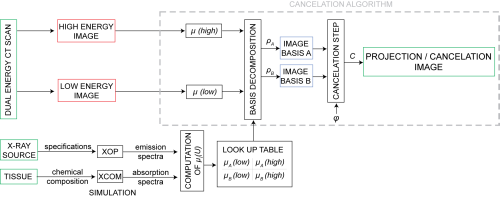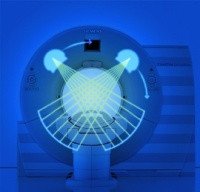Dual Energy CT
Although computed tomography examinations are well suited for the automatic detection of calcified plaques, the same cannot be said for the assessment of lipid plaque constituents. A moderate contrast between lipid and surrounding tissues normally even hinders a proper manual assessment. One reason for this poor contrast is that with commonly used single source computed tomography systems different materials can show very similar attenuation at any selected radiation energy. The recently introduced dual energy CT system, however, simultaneously measures attenuations at two energies and therefore shows promise to improve the differentiation of tissues to some extent.
We have evaluated this technique for the assessment of atherosclerosis. With a tissue cancelation algorithm that had been adapted for plaque assessment, we could show a contrast enhancement of up to 67% between all targeted tissues (lumen, adipose, calcium, soft tissue) for plaque assessment. The idea of the tissue cancelation algorithm is to decompose the orignal low and high energy images into two basis material images to map the density distribution of two arbitrarily chosen basis materials A and B. Thereafter, the two bases are combined in a cancelation step to a single projection or cancelation image to enhance or cancel the contrast between targeted tissues.
Workflow of the tissue cancelation algorithm.


Dual Energy CT system. Picture in courtesy of Siemens Healthcare, Forchheim, Germany
Corresponding publication:
Saur S.C., Regazzoni L., Eugster S., Székely G., Cattin Ph. C.,
"Contrast Enhancement with Dual Energy CT for the Assessment of Atherosclerosis", Bildverarbeitung für die Medizin, p. 61-65, 2009.
free link


 Dual Energy CT system. Picture in courtesy of Siemens Healthcare, Forchheim, Germany
Dual Energy CT system. Picture in courtesy of Siemens Healthcare, Forchheim, Germany